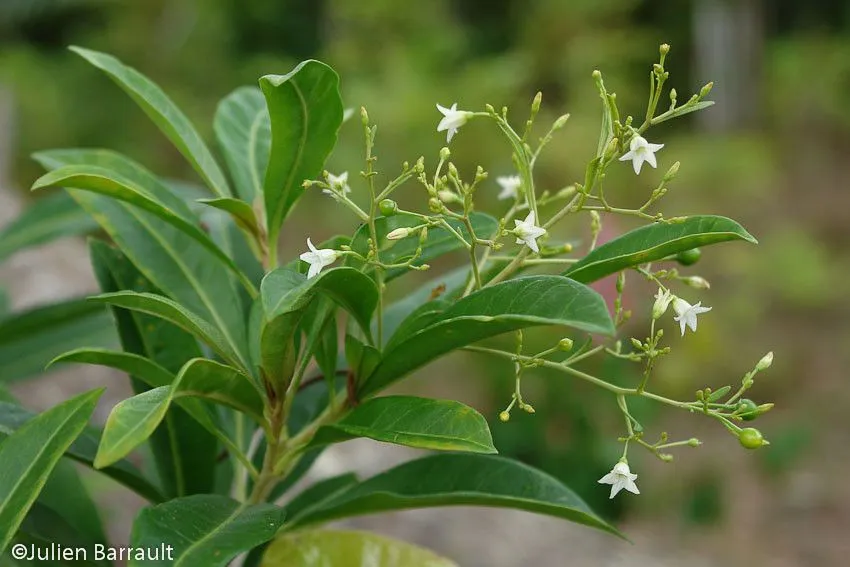
Author: R.Br.
Bibliography: Prodr. Fl. Nov. Holland.: 448 (1810)
Year: 1810
Status: accepted
Rank: species
Genus: Duboisia
Vegetable: False
Observations: E. Australia, New Caledonia
The Corkwood tree, known scientifically as Duboisia myoporoides, is a significant species native to Eastern Australia and New Caledonia. This fascinating tree belongs to the Solanaceae family, a diverse family that showcases a wide array of plants, from delicate herbs to robust trees.
Duboisia myoporoides was described in the early 19th century, with its formal classification being published in Robert Brown’s “Prodromus Florae Novae Hollandiae” in 1810. This historical text highlights the richness and diversity of the Australian flora during the period of early botanical exploration.
Thriving in various habitats within its native range, the Corkwood tree is particularly noted for its ecological and pharmacological importance. The tree is medium-sized, with distinctive soft and light-colored wood, features which are likely the inspiration for its common name. Its leaves are ovate to lanceolate, contributing to the tree’s lush green appearance, and it produces small, white to pale purple flowers arranged in clusters. These flowers, though understated, lead to the formation of berry-like fruits which add a layer of interest to the tree’s yearly cycle.
One of the most remarkable aspects of the Corkwood tree is its alkaloid content, particularly hyoscine and scopolamine, which are of significant medical and pharmaceutical interest. These compounds have potent anticholinergic properties, making Duboisia myoporoides an important source of active ingredients for medications used to treat motion sickness, postoperative nausea, and other conditions. The extraction and refinement of these alkaloids have thus made the tree an invaluable plant in modern medicine.
In addition to its pharmaceutical uses, the Corkwood tree also plays a crucial environmental role within its native ecosystem. It provides habitat and nourishment for various insect species, birds, and small mammals, contributing to the biodiversity of the regions in which it is found. Its presence within ecosystems acts as a stabilizing factor, supporting diverse life forms and maintaining ecological balance.
In summary, the Corkwood tree, Duboisia myoporoides, stands out not only for its distinctive physical characteristics and ecological significance but also for its remarkable contributions to the field of medicine. Its historical documentation in 1810 by R. Br. provides a glimpse into its long-standing importance and continued relevance in both natural and scientific communities.
Eng: corkwood tree, corkwoodtree, eye-opening-tree, eyeplant, hard corkwood, poison corkwood, poisonous corkwood, soft corkwood, yellow-basswood
Por: corticeira, duboisia
Swe: duboisia
En: Corkwood tree, Corkwoodtree, Eye-opening-tree, Eyeplant, Hard corkwood, Poison corkwood, Poisonous corkwood, Soft corkwood, Yellow-basswood
Pt: Corticeira, Duboisia
Sv: Duboisia
Taken Aug 17, 2007 by Endemia – Julien Barrault (cc-by-nc)
Taken Oct 10, 2015 by Endemia – Benoît Henry (cc-by-nc)
Taken Jan 1, 1970 by Endemia – Bernard Suprin (cc-by-nc)
Taken Jun 25, 2014 by Endemia – Gildas Gâteblé (IAC) (cc-by-nc)
Taken Jun 25, 2014 by Endemia – Gildas Gâteblé (IAC) (cc-by-nc)
Taken Oct 10, 2015 by Endemia – Benoît Henry (cc-by-nc)
Taken Aug 17, 2007 by Endemia – Julien Barrault (cc-by-nc)
Taken Aug 17, 2007 by Endemia – Julien Barrault (cc-by-nc)
Taken Jan 1, 1970 by Endemia – Bernard Suprin (cc-by-nc)
Taken Jan 1, 1970 by Endemia – Bernard Suprin (cc-by-nc)
Taken Oct 10, 2015 by Endemia – Benoît Henry (cc-by-nc)
© copyright of the Board of Trustees of the Royal Botanic Gardens, Kew.
© copyright of the Board of Trustees of the Royal Botanic Gardens, Kew.
Family: Myrtaceae Author: (F.Muell.) K.D.Hill & L.A.S.Johnson Bibliography: Telopea 6: 402 (1995) Year: 1995 Status:…
Family: Rubiaceae Author: Pierre ex A.Froehner Bibliography: Notizbl. Bot. Gart. Berlin-Dahlem 1: 237 (1897) Year:…
Family: Sapindaceae Author: Koidz. Bibliography: J. Coll. Sci. Imp. Univ. Tokyo 32(1): 38 (1911) Year:…
Family: Asteraceae Author: A.Gray Bibliography: Pacif. Railr. Rep.: 107 (1857) Year: 1857 Status: accepted Rank:…
Family: Fabaceae Author: Medik. Bibliography: Vorles. Churpfälz. Phys.-Ökon. Ges. 2: 398 (1787) Year: 1787 Status:…
Family: Aspleniaceae Author: (Cav.) Alston Bibliography: Bull. Misc. Inform. Kew 1932: 309 (1932) Year: 1932…